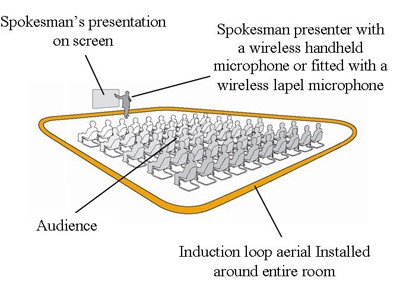Hearing Loops – Helping the Hard of Hearing Community
January 9, 2018 Newsroom
What’s all this noise about Hearing Loops?
As you may have heard, New York City has recently signed into law a requirement for Hearing Loops to be installed in building projects of a certain size, that are funded by the NYC Treasury Department. Hearing loops are a clever technology that harness the power of electromagnetic waves to directly transmit sound to compatible hearing aids; they assist in amplifying desired sounds and reducing background noise, inconspicuously and inexpensively, in all kinds of situations from large assembly halls to ticket counters. The technology has been employed in Europe for some time and is starting to gain some traction within the United States. Continue on for more information on the NYC local law and the technology…
Summary of Local Law
Signed into law on 3/17/17, and taking effect this year, Local Law 51 of 2017 amends the New York City charter to require the installation of Induction Hearing Loops in places of assembly where the project is funded solely, or partially by the NYC Treasury. A project would require a hearing loop if the following requirements are met:
1. The project contains a space that is defined as an assembly area by the 2010 ADA Standards. These include spaces that are used for entertainment (concert halls, movie theatres, auditoriums) and civic meeting (public meeting halls and hearing rooms). The Local Law excludes classrooms in schools, outdoor facilities (stadiums, amphitheaters), courthouses, and facilities used to deploy first responders from the definition of assembly area.
2. The project must be a capital project where at least 51% of the construction cost or more than $1M is paid by the city treasury. Projects with a baseline construction cost of $950,000 or greater must comply. This is the cost of construction before the cost of a required hearing loop system. This requirement includes new construction and renovations. Capital projects that involve the construction or renovation of assembly areas not owned by the City are at present exempt.
The Technology
There are three parts to a hearing loop; the audio input, amplifier, and loop aerial. The audio input could be anything from a microphone to a music player. The amplifier takes the audio from the input device processes, and strengthens it, then sends the signal to the loop aerial. The signal travels through the loop aerial, which is a simple copper wire loop and can be received by any compatible hearing device (those with a “T” switch). Normally, hearing aids amplify all sounds, including background noise. Using a hearing loop with a compatible aid allows the listener to receive the sound directly from the audio source and cancels out most background noise.
Hearing loops can be designed for large meeting rooms or be designed small enough to work on a countertop. As a matter of fact, hearing loops already exist in the majority of NYC subway station booths and some NYC Taxis! Figures 1 and 2 show a typical loop set up in an assembly space and the sign that is required to be displayed when a hearing loop is installed and available, respectively.

Figure 1 – A perimeter hearing loop for a large room (e.g. special events, places of worship, theatre, etc.), What is a Hearing Loop?, HearingLink.org, 1/26/18

Figure 2 – Signage alerting patrons of the presence of a hearing loop, Hearing Loop, The Hearing Connection, 2/6/18
Design Considerations
Just as any other building system, preparations must be taken during the design to ensure that the audio induction loop is working properly. The international standard IEC 60118-4 exists to ensure that systems are designed to produce uniform, clear sound. The standard addresses obstacles to ideal system functionality including loop positioning, overspill, and interference. Loops need to be positioned so that listeners can comfortably receive sound. If a loop is positioned incorrectly, a listener may receive a sound that is too strong or too weak. Depending on the size of the loop, the sound will be able to “spill” outside of the room and design will need to be modified so that reception is contained to the intended audience. Metal structures and electromagnetic interference from electrical equipment will also affect the loop’s signal strength and quality. With all these factors that can affect the audio loop performance, careful planning must be taken in designing an appropriate loop.
If your project falls within the requirements of Local Law 51 or if you believe that installing a hearing loop would benefit your business, contact us today!
– Mario DiMondo, Electrical Engineer
